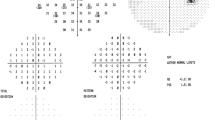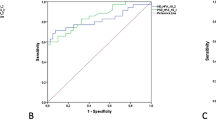Abstract
To test whether multifocal visual evoked potential (mfVEP) recording using two perpendicularly placed channels, as previously reported, to measure the degree of signal-to-noise ratio (SNR) distribution overlap between a signal window and a noise window would efficiently detect and quantify glaucomatous damage. Humphrey visual field (HVF) and mfVEP were recorded from 56 patients with primary open-angle glaucoma and mean deviation less than −15 dB and 62 age-matched ophthalmologically normal individuals. Areas under the receiver-operating characteristic curve (SNR-AUC) were calculated based on the proportion of mfVEP responses that exceeded a specific SNR criterion for both windows. Abnormal sectors with an SNR deviated from the previously established norm with P < 5% and 1% were counted. Diagnostic accuracy of the SNR-AUC was similar to that of the average total deviation (TD) of the HVF. The hemifield agreement to detect a defect in mfVEP and HVF was 77.1–87.3%, which was similar to previous reports using multiple channels. Correlation coefficients between SNR-AUC and average TD (0.74 in the upper hemifield and 0.65 in the lower) were significantly higher than those between the sums of abnormal locations on the mfVEP and HVF probability plots (0.27 and 0.33, respectively). Two perpendicular channels can detect and quantify functional damage due to glaucoma. The SNR-AUC may be used as a global index to quantify diffuse glaucomatous functional loss.



Similar content being viewed by others
References
Baseler HA, Sutter EE, Klein SA, Carney T (1994) The topography of visual evoked response properties across the visual field. Electroencephalogr Clin Neurophysiol 90:65–81
Klistorner AI, Graham SL, Grigg JR, Billson FA (1998) Multifocal topographic visual evoked potential: improving objective detection of local visual field defects. Invest Ophthalmol Vis Sci 39:937–950
Klistorner A, Graham SL (2000) Objective perimetry in glaucoma. Ophthalmology 107:2283–2299
Hood DC, Greenstein VC (2003) Multifocal VEP and ganglion cell damage: applications and limitations for the study of glaucoma. Prog Retin Eye Res 22:201–251
Zhang X, Hood DC, Chen CS, Hong JE (2002) A signal-to-noise analysis of multifocal VEP responses: an objective definition for poor records. Doc Ophthalmol 104:287–302
Hood DC, Zhang X, Winn BJ (2003) Detecting glaucomatous damage with multifocal visual evoked potentials: How can a monocular test work? J Glaucoma 12:3–15
Hood DC, Zhang X, Greenstein VC, Kangovi S, Odel JG, Liebmann JM, Ritch R (2000) An interocular comparison of the multifocal VEP: a possible technique for detecting local damage to the optic nerve. Invest Ophthalmol Vis Sci 41:1580–1587
Goldberg I, Graham SL, Klistorner AI (2002) Multifocal objective perimetry in the detection of glaucomatous field loss. Am J Ophthalmol 133:29–39
Bjerre A, Grigg JR, Parry NR, Hensen DB (2004) Test-retest variability of multifocal visual evoked potential and SITA standard perimetry in glaucoma. Invest Ophthalmol Vis Sci 45:4035–4040
Hood DC, Thienprasiddhi P, Greenstein VC, Winn BJ, Ohri N, Liebmann JM, Ritch R (2004) Detecting early to mild glaucomatous damage: a comparison of the multifocal VEP and automated perimetry. Invest Ophthalmol Vis Sci 45:492–498
Graham SL, Klistorner A, Goldberg I (2005) Clinical application of objective perimetry using multifocal visual evoked potentials in glaucoma practice. Arch Ophthalmol 123:729–739
Balachandran C, Graham SL, Klistorner A, Goldberg I (2006) Comparison of objective diagnostic tests in glaucoma. Heidelberg retinal tomography and multifocal visual evoked potentials. J Glaucoma 15:110–116
Fortune B, Demirel S, Zhang X, Hood DC, Patterson E, Jamil A, Mansberger SL, Cioffi GA, Johnson CA (2007) Comparing multifocal VEP and standard automated perimetry in high-risk ocular hypertension and early glaucoma. Invest Ophthalmol Vis Sci 48:1173–1180
Meigen T, Krämer M (2007) Optimizing electrode positions and analysis strategies for multifocal VEP recordings by ROC analysis. Vis Res 47:1445–1454
Ishikawa K, Nagai T, Yamada Y, Negi A, Nakamura M (2011) Optimal conditions for multifocal VEP recording for normal Japanese population established by receiver operating characteristic analysis. Doc Ophthalmol 122:29–37
Kanamori A, Naka M, Nagai-Kusuhara A, Yamada Y, Nakamura M, Negi A (2008) Regional relationship between retinal nerve fiber layer thickness and corresponding visual field sensitivity in glaucomatous eyes. Arch Ophthalmol 126:1500–1506
Anderson D, Pattela V (1992) Automated static perimetry, 2nd edn. St Louis, Missouri, pp 143–153
Hood DC, Greenstein VC, Odel JG, Zhang X, Ritch R, Liebmann JM, Hong JE, Chen CS, Thienprasiddhi P (2002) Visual field defects and multifocal visual evoked potentials. Evidence of a linear relationship. Arch Ophthalmol 120:1672–1681
Hood DC, Kardon RH (2007) A framework for comparing structural and functional measures of glaucomatous damage. Prog Retin Eye Res 26:688–710
DeLong ER, DeLong DM, Clarke-Pearson DL (1988) Comparing the areas under two or more correlated receiver operating characteristic curves: a nonparametric approach. Biometrics 44:837–845
Hanley JA, McNeil BJ (1982) The meaning and use of the area under a receiver operating characteristic curve. Radiology 143:29–36
Vida S (1993) A computer program for non-parametric receiver operating characteristic analysis. Comput Methods Programs Biomed 40:95–101
Landis JR, Koch GG (1977) The measurement of observer agreement for categorical data. Biometrics 33:159–174
Leeprechanon N, Giangiacomo A, Fontana H, Hoffman D, Caprioli J (2007) Frequency-doubling perimetry: comparison with standard automated perimetry to detect glaucoma. Am J Ophthalmol 143:263–271
Acknowledgments
This study was supported in part by Grants-in-Aid 22390324 (A.N., Y.Y., M.N.) and 20592043 (M.N., A.N.) from the Ministry of Education, Culture, Sports, and Science and Technology of the Japanese government.
Conflict of interest
None.
Author information
Authors and Affiliations
Corresponding author
Rights and permissions
About this article
Cite this article
Nakamura, M., Ishikawa, K., Nagai, T. et al. Receiver-operating characteristic analysis of multifocal VEPs to diagnose and quantify glaucomatous functional damage. Doc Ophthalmol 123, 93–108 (2011). https://doi.org/10.1007/s10633-011-9285-y
Received:
Accepted:
Published:
Issue Date:
DOI: https://doi.org/10.1007/s10633-011-9285-y




